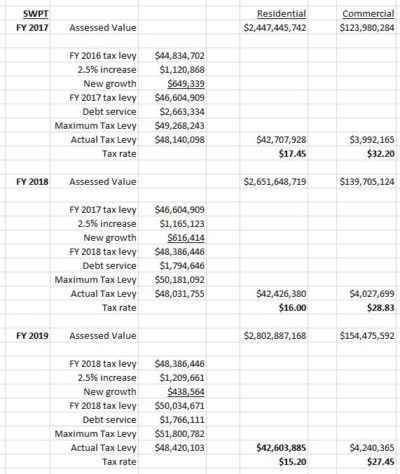How is Swampscott’s 2019 Property Tax Rate calculated?
Swampscott has announced that its residential tax rate will drop from $16.00 in Fiscal Year 2018 to $15.20 in FY 2019 (and down from $17.45 in FY 2017).
Commercial and industrial property is surcharged at 170%, as in FY 2018, resulting in a tax rate of $27.45, down from $28.83 in FY 2018 and $32.20 in FY 2017 (when the shift was 175%).
Were a single tax rate to be enacted – meaning that residential and commercial property were taxed at the same rate – that rate would be $16.05 for FY 2019.
How is the rate calculated?
The method of calculating the tax rate is quite simple: take the $ amount of the previous year’s tax levy, add 2.5% for Proposition 2 1/2, and also add any new growth (such as new construction or a condo conversion). This figure is the new maximum tax levy. To this figure is added debt service – the Principal and Interest payable on the town’s debt. Note that in recent years, Swampscott has not assessed the maximum allowed under this formula, a decision that has reduced the tax bill for residents. The average tax bill will decline by $51 in FY 2019, a second consecutive year of decline, after rising in every year since 1994.
Here are the numbers for FY 2017, 2018 and 2019, remembering that the FY runs from July to June.

The Tax Levy calculation
The maximum $ amount that can be raised by the property tax will increase year by year. That is because of the formula: last year’s number plus 2.5% (Prop 2 1/2) plus new growth. In the table above you can see how the FY 2018 maximum tax levy of $48,386,446 becomes the base for FY 2019. Add $1,209,661 for Prop 2 1/2 and new growth of $438,564 to get the new figure of $50,034,671. To this number is added the debt service – Principal and Interest on the town’s debt, much as homeowners pay P&I on their mortgage. Note that the actual tax levy was less than the maximum allowed by just over $1 million in FY 2017, by just over $2 million in FY 2018, and by $3.4 million in FY 2019. In other words, the amount raised through taxes was reduced by these amounts each year.
The Tax Rate
The actual tax rate depends upon the total Assessed Value of all property: residential, and commercial, industrial and personal (CIP). The tax rate is calculated by dividing the total dollar amount to be raised from each class by the Assessed Value of each class. Thus, the headline tax rate will also fluctuate depending upon the direction of Assessed Values.
In simplistic terms, if we assume that the $ amount to be raised increases by a little more than 2 1/2% each year, then if the average Assessed Value also increases by a little more than 2 1/2% the tax rate will be unchanged. If the increase in Assessed Values is less than 2 1/2%, then the tax rate will rise. And if the increase in Assessed Values is more than 2 1/2% then the tax rate will fall. In recent years Assessed Values have been increasing significantly more than 2 1/2% allowing for the tax rate to decline sharply.
Looking at the Swampscott residential tax rate, in FY 2018 it was $16.00, achieved by dividing $42.4 million raised from residential homeowners by the residential AV of $2.65 billion. In FY 2019 the amount to be raised from residential taxpayers is set to increase slightly to $42.6 million, but because the total residential AV increased by 5.7% to $2.8 billion, the headline tax rate dropped sharply to just $15.20, the lowest figure since 2009.
Comment
The residential real estate market in Swampscott has been very strong again in 2018 (and 2018 prices will be the basis for the FY 2020 tax rate). At this stage it looks as though the median price will be around $580,000 (a new high), an increase of over 9% from 2017’s $530,000. But bear in mind this is the median price of the SFHs that will actually sell this year, so does not imply that the Town’s residential Assessed Value will increase by 9%.
As to the tax rate for FY 2020, that depends on a number of factors: the amount of debt service, how much of the maximum tax levy is assessed, and the shift to the CIP class being three of them. But the continuing increase in Assessed Values should allow for the actual rate to decline again in FY 2020..
From a real estate perspective, the substantial decline in the tax rate and the stability in tax bills are both very welcome news and are clearly encouraging more people to decide both to live and work in Swampscott.
www.OliverReports.com
